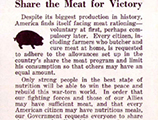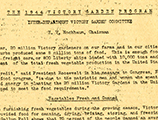Rationing and Victory Gardens
Information for Teachers
Citizens on the homefront volunteered in record numbers to aid the war effort. They planted victory gardens, joined civil defense organizations, and participated in various rationing efforts.
United behind the war effort like never before, Floridians participated in both voluntary and mandatory efforts to conserve strategic war materials. Drives to collect rubber, scrap metal, rags, paper, and grease became popular, as did “meatless” days to stretch the nation's food resources. Every man, woman, and child in the state received a ration book limiting what could be purchased.
Rationing
During World War II, shortages of a variety of civilian goods became commonplace. To ensure fair distribution, and that vital materials would be conserved for military use, the Federal government implemented a rationing policy on a wide variety of products. Gasoline, rubber, bicycles, shoes, sugar, fruits and vegetables, fats and oils, cheese, coffee, butter, meats, fish, certain canned goods, and even dried peas and beans were among the many products rationed for all or part of the war.
Many other non-rationed items were in chronically short supply and virtually impossible to obtain. One historian has written that “[a]s the war drew on, nearly every item Americans ate, wore, used or lived in was rationed or otherwise regulated. It was the most concerted attack on wartime inflation and scarcity in the nation’s history and by and large it worked.”
To enforce the system, the Office of Price Administration issued ration books for gasoline and foodstuffs, which civilians had to present and turn over the required ration coupons before they were allowed to purchase the rationed item. To ensure cooperation, the Office of War Information (OWI) provided information to the public on the often confusing system.
Share the Meat
The documents included here deal with the “Share the Meat” program promoted by the War Food Administration during World War II. The program urged Americans to limit their weekly consumption of meat. The program was designed to ensure the supply of adequate meat to feed troops serving overseas, and to encourage voluntary participation in rationing on the homefront.
The first document is a press release designed for publication prior to Thanksgiving in 1942. The document explains that Americans should feel fortunate for the supply of meat they have and that participating in the program is a small sacrifice compared to the hardships endured by citizens in enemy-controlled territory. The document provides a thought provoking commentary on the relative affluence of American citizens during a time of great turmoil and suffering in Europe, Asia, and northern Africa.
The second document is also a press release. This document encourages pet owners to modify the amount of red meat fed to dogs and cats, and to take what they feed to pets into consideration when planning to participate in the Share the Meat program. This document is an example of the information disseminated to citizens on the homefront to encourage greater participation in wartime rationing programs.
The third document is brochure. Save and Serve: Share the Meat for Victory encourages farmers to grow, process and store their home meat supply. With recipes for liver pudding and guidelines for how neighbors can form a “Farmer’s Beef Club,” farmers are encouraged to “aid the war effort, bring victory and write the peace.”
Victory Gardens
Maintaining an adequate food supply, both on the homefront and for troops serving overseas, was a critical component of U.S. military strategy during World War II. As the war intensified, U.S. military personal required a greater share of commercially produced food. This meant that citizens on the homefront had less access to mass-produced foods like canned fruits, vegetables, meats, and seafood.
In order to make up for the deficit on the homefront, the War Food Administration encouraged citizens to plant “Victory Gardens.” Victory gardens ranged from small plots in suburban neighborhoods, to large community efforts. Victory gardeners primarily grew vegetables and fruits for home consumption. Participants also learned how to can fruits and vegetables for later use, and to properly care for the soil to ensure multiple planting cycles.
Millions of Americans planted or helped tend victory gardens. According to the document included here, in 1943 there were 20 million victory gardens in the United States. Florida was especially suited for victory gardens because the climate allowed for year-round planting and multiple harvests. Historian Gary Mormino wrote that Tampa boasted about 10,000 victory gardens in 1943.
This document is an official statement from the War Food Administration on the accomplishments and future plans for expanding victory gardens during World War II. It explains the multiple reasons for planting victory gardens, including national defense, community morale, nutrition, and soil preservation. This document helps us understand the collective effort on the part of millions of Americans to produce food for consumption on the homefront, so that commercially produced foods could be sent overseas to feed American soldiers on the battlefields of Europe, African, and Asia.
Documents
Use to Illustrate:
- The impact of World War II on the homefront.
- Rationing during World War II in the United States.
- The impact of food rationing in the United States on meat consumption during World War II.
- The role of victory gardens and gardeners in the war effort.
- The role of Florida, because of its climate and soil conditions, in the drive to plant and expand Victory Gardens.
Relevant NGSSS
- SS.4.A.1.1: Analyze primary and secondary resources to identify significant individuals and events throughout Florida history.
- SS.4.A.7.3: Identify Florida's role in World War II.
Examples may include, but are not limited to, warfare near Florida’s shores and training bases in Florida (Miami, Tampa, Tallahassee, etc.), spying near the coast, Mosquito Fleet. - SS.912.A.6.1: Examine causes, course, and consequences of World War II on the United States and the world.
- SS.912.A.6.15: Examine key events and peoples in Florida history as they relate to United States history.
Examples may include, but are not limited to, Mosquito Fleet, “Double V Campaign”, construction of military bases and WWII training centers, 1959 Cuban coup and its impact on Florida, development of the space program and NASA.
- SS.912.A.6.4: Examine efforts to expand or contract rights for various populations during World War II.
Examples may include, but are not limited to, women, African-Americans, German Americans, Japanese Americans and their internment, Native Americans, Hispanic Americans, Italian Americans.
- SS.912.A.6.5: Explain the impact of World War II on domestic government policy.
Examples may include, but are not limited to, rationing, national security, civil rights, increased job opportunities for African-Americans, women, Jews, and other refugees.
Florida Standards
- LAFS.4.RI.1.1: Refer to details and examples in a text when explaining what the text says explicitly and when drawing inferences from the text.
- LAFS.68.RH.1.1: Cite specific textual evidence to support analysis of primary and secondary sources.
- LAFS.68.RH.1.2: Determine the central ideas or information of a primary or secondary source; provide an accurate summary of the source distinct from prior knowledge or opinions.
- LAFS.910.RH.1.1: Cite specific textual evidence to support analysis of primary and secondary sources, attending to such features as the date and origin of the information.
- LAFS.910.RH.1.2: Determine the central ideas or information of a primary or secondary source; provide an accurate summary of how key events or ideas develop over the course of the text.
- LAFS.910.RH.2.6: Compare the point of view of two or more authors for how they treat the same or similar topics, including which details they include and emphasize in their respective accounts.
- LAFS.910.RH.3.9: Compare and contrast treatments of the same topic in several primary and secondary sources.
- LAFS.1112.RH.1.1: Cite specific textual evidence to support analysis of primary and secondary sources, connecting insights gained from specific details to an understanding of the text as a whole.
- LAFS.1112.RH.1.2: Determine the central ideas or information of a primary or secondary source; provide an accurate summary that makes clear the relationships among the key details and ideas.
- LAFS.1112.RH.2.5: Analyze in detail how a complex primary source is structured, including how key sentences, paragraphs, and larger portions of the text contribute to the whole.

 Listen: The Folk Program
Listen: The Folk Program

